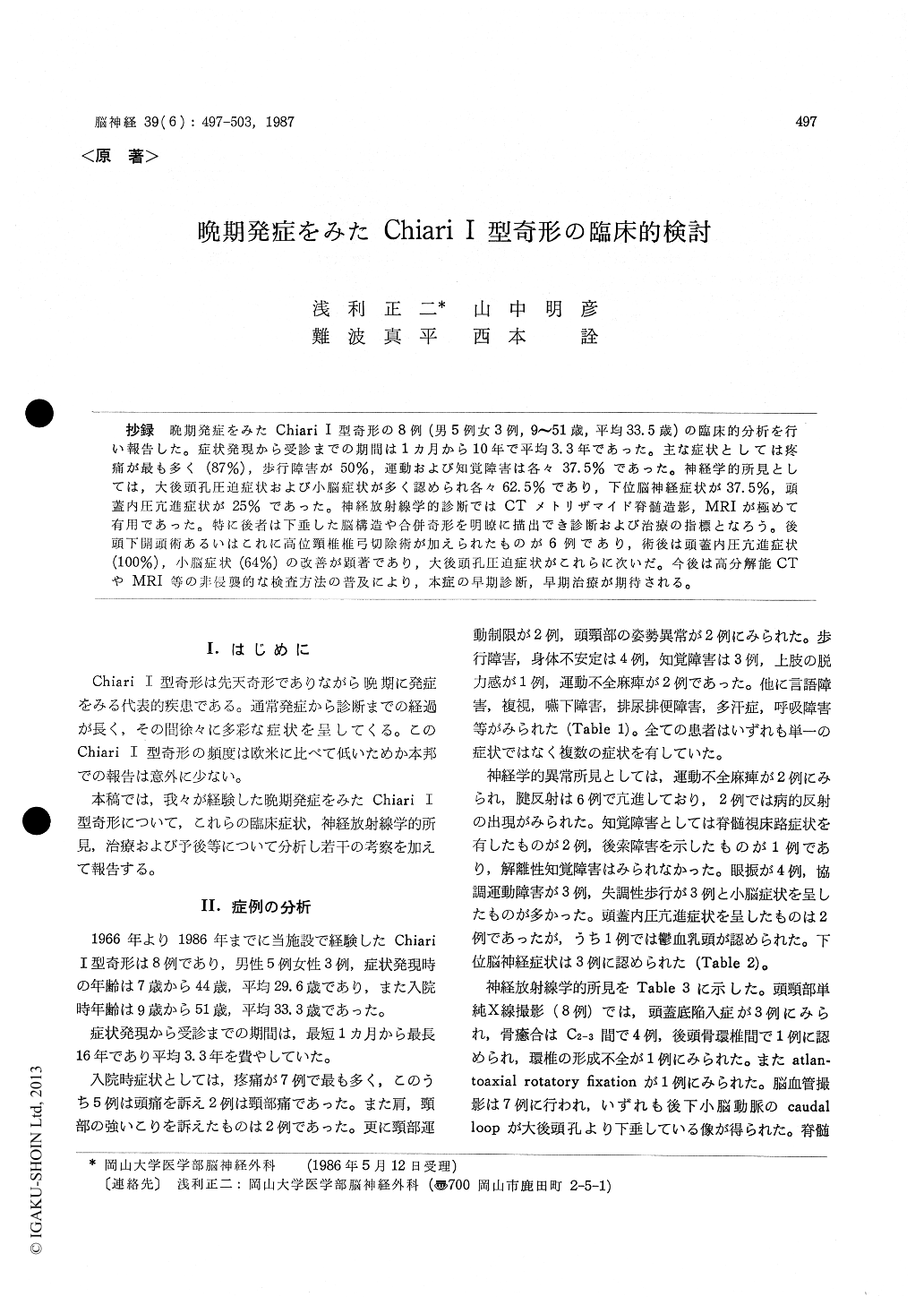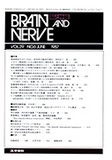Japanese
English
- 有料閲覧
- Abstract 文献概要
- 1ページ目 Look Inside
抄録 晩期発症をみたChiari I型奇形の8例(男5例女3例,9〜51歳,平均33.5歳)の臨床的分析を行い報告した。症状発現から受診までの期間は1ヵ月から10年で平均3.3年であった。主な症状としては疼痛が最も多く(87%),歩行障害が50%,運動および知覚障害は各々37.5%であった。神経学的所見としては,大後頭孔圧迫症状および小脳症状が多く認められ各々62.5%であり,下位脳神経症状が37.5%,頭蓋内圧亢進症状が25%であった。神経放射線学的診断ではCTメトリザマイド脊髄造影,MRIが極めて有用であった。特に後者は下垂した脳構造や合併奇形を明瞭に描出でき診断および治療の指標となろう。後頭下開頭術あるいはこれに高位頸椎椎弓切除術が加えられたものが6例であり,術後は頭蓋内圧亢進症状(100%),小脳症状(64%)の改善が顕著であり,大後頭孔圧迫症状がこれらに次いだ。今後は高分解能CTやMRI等の非侵襲的な検査方法の普及により,本症の早期診断,早期治療が期待される。
Eight cases, 5 males and 3 females, of Chiari type 1 malformation aged from 9 to 51 years (mean 33.3 years) were analysed. The average age of the onset of symptoms was 29.6 years, between 7 and 44 years, and that from the onset of symptoms to the presentation to the hospital was 3.3 years ranged from 1 month to 16 years.
Pain (87%) in the head or in the cervical region was the most common symptoms, the former was 5 cases and the latter was 2. The next common symp-toms were unsteadiness and gait disturbance (50 %). Weakness of one or more limbs was the complaints of 3 (38%) of the patients, and sensory impairment was 38%. Other symptoms included stiffness of the neck and shoulder, limitation of the neck movement, abnormal head posture, rectouri-nary incontinence and so on.
In physical examination, foramen magnum com-pression signs (63%) and cerebellar signs (63%) were most common and lower cranial nerve palsy (38%) and intracranial hypertension (25%) were included.
Abnormalities of the skull and cervical spine were common on X-ray films. There were cervi-cal fusion or occipitalization and basilar impres-sion. On the angiograms, descended PICA was vi-sualized in all cases. CT metrizamide myelogra-phy was perfomed in 2 cases and MRI was done in 1 case. They could clearly demonstrate the des-cended tonsils and were found to be the most reli-able radiographic examination in the disease.
Suboccipital craniectomy and C1-C2 laminectomy were performed in 6 cases. Some abnormal con-ditions were found at operation. The level of tonsillar herniation was varied, namely, 1 case was at C3, 3 were at C2 and 1 was just below the fora-men magnum. Herniation was asymmetrical in 3 cases. Dural band or thick arachnoid was found in 3 cases and tissue adhesions were in 4. Syringo-myelia was not seen in our cases. Partial resection of the descended tonsils was done in 3 cases. His-tological examinations revealed mild gliosis in the molecular layer, degeneration of Purkinje's cells and decreased cellularity in the granular layer.
Postoperatively, we took good results in many symptoms such as pain, stiffneck or limited neck movement etc. Cerebellar dysfunction (64%), low-er cranial nerve palsy (67%), and intracranial hypertension (100%) had good prognosis. Sleep apnea occured transiently in 1 case postoperatively.
High resolution CT and MRI appears to be par-ticularly useful in an early diagnosis of this condi-tion.

Copyright © 1987, Igaku-Shoin Ltd. All rights reserved.


